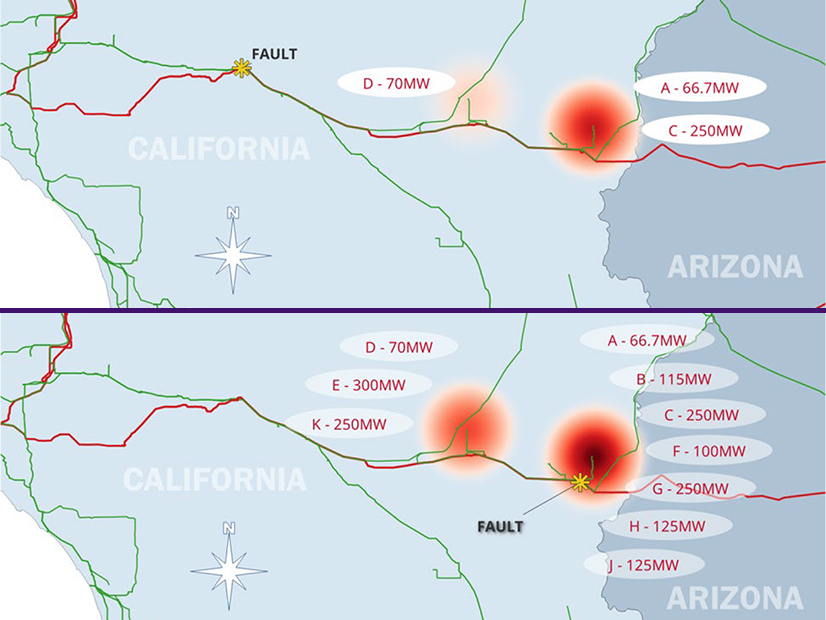
Battery energy storage systems (BESS) may be vulnerable to the same systemic performance problems seen in several disturbances in solar generators and other inverter-based resources (IBR) over the past few years, according to a joint report released by NERC and WECC on Monday.
The 2022 California Battery Energy Storage System Disturbances report concerns two events that occurred in Southern California last year and resulted in the loss of significant amounts of BESS in the region. According to NERC and WECC, they are the first major grid events to involve battery facilities and demonstrate why grid planners “need to consider these systems in the same light as any other” IBR.
The first event began just after 6 p.m. Pacific Time on March 9, when a generator circuit breaker at a natural gas-fired simple-cycle facility in Riverside County, Calif., suffered an internal failure, causing a generator bus fault. Generator units relayed and disconnected the natural gas generators, which were producing 694 MW, and the fault was cleared after about 4.5 cycles.
At the same time, IBRs at several facilities unexpectedly reduced output by a collective 408 MW. 124 MW of this reduction was attributed to BESS. As a result, the total generation loss topped out at 1,102 MW and system frequency dropped to 59.916 Hz. In response, CAISO raised regulating unit output, and frequency returned to normal in three minutes.
The second event began at 3:06 p.m. PT when a B-phase-to-ground fault occurred on a 220 kV bus at a new BESS plant that was still undergoing testing. While the fault was cleared normally in about four cycles, it caused a further unexpected reduction of output from multiple IBRs — including both battery and solar facilities — totaling 498 MW. CAISO again raised regulating unit output to assist in the recovery from the frequency nadir of 59.924 Hz, and frequency returned to normal in one and a half minutes.
Three BESS facilities were involved in both events: a 66-MW facility containing 29 inverters, a 250-MW facility with 88 inverters, and a 70-MW hybrid solar and BESS facility with 13 battery inverters. In addition, the April event involved an additional BESS unit rated for 115 MW and containing 45 inverters.
Causes of Reduction Unclear
NERC and WECC identified inverter AC overcurrent tripping and unbalanced AC current tripping as the cause of reduction for two of the battery facilities involved in the March event. The reduction in the third battery plant was caused by DC bus voltage undervoltage for two of the 13 inverters involved. Investigators have been unable to determine the reason the remaining 11 inverters tripped.
Determining the reason for reduction in the April event was more difficult because of incomplete data from three of the four BESS facilities involved. However, investigators concluded that in one of the plants — which suffered reductions in both events — inverters tripped due to a mix of AC overcurrent tripping, unbalanced AC current tripping, DC bus unbalance, half bus DC voltage max, DC bus overvoltage and high AC voltage.
According to records, five inverters tripped in the plant that was involved in only the April event. Three tripped because of unbalanced AC current protection; the cause of the other trips is still unknown. However, the report suggested record quality may still be an issue because the output of the five inverters that tripped “does not add up to the total 26 MW lost.”
The cause of tripping could not be determined for the remaining two plants because of faulty recording at one facility and a lack of metering data for the other, which is part of a multiphase project for which data at individual plants was not available.
NERC and WECC recommendations for utilities include checking for causes of tripping identified in both this and previous IBR incident reports. Generator owners should even check for causes of tripping in incidents that did not involve BESS facilities; the ERO explained that “causes … associated with solar PV resources” had been found in the most recent incident as well.
The report also warned that transmission owners and GOs should assess BESS ride-through performance during the interconnection process, while transmission planners and planning coordinators should also “conduct ride-through performance assessments … and confirm that installed equipment, performance and capabilities match those in the studied models.” NERC plans to assess the quality of performance modeling for the affected facilities.
Finally, NERC and WECC warned that the lack of data on the incident made deep analysis of the event challenging. The report noted that none of the facilities involved met CAISO’s 10-millisecond recording data resolution requirements. Other “significant data quality issues” included a lack of individual facility metering, inconsistency between BESS data and CAISO data, and the tendency of monitors at several facilities to freeze recording at the onset of the fault.
IBR Issues Continuing
While the March and April events are the first significant disturbances on record involving battery facilities, the ERO has long been familiar with the sometimes-unexpected behavior of other IBRs like wind and solar generators. Just last month, NERC and WECC released a joint report on a Utah event in which nine solar facilities lost a total of 921 MW of generation. (See NERC Utah Event Report Underlines Ongoing IBR Issues.) Previous reports have detailed multiple similar events in California and Texas. (See NERC, WECC Repeat Solar Performance Warnings.)
“These events are the first faint signal that the systemic performance issues we have identified with other inverter-based technologies may very likely apply here as well,” Ryan Quint, NERC’s director of engineering and security integration, said in a statement. “Battery … systems will play a critical role during the energy transition; therefore, it is imperative that we design, study, commission and operate them in a manner that supports [grid] reliability.”

